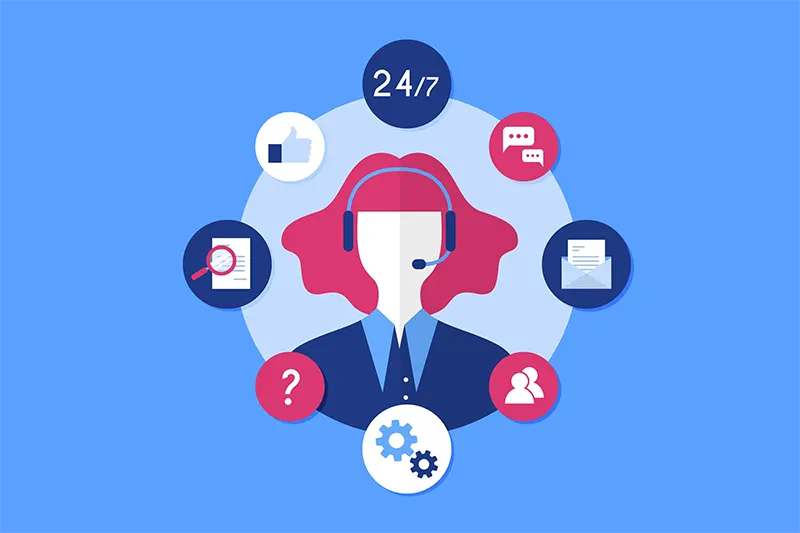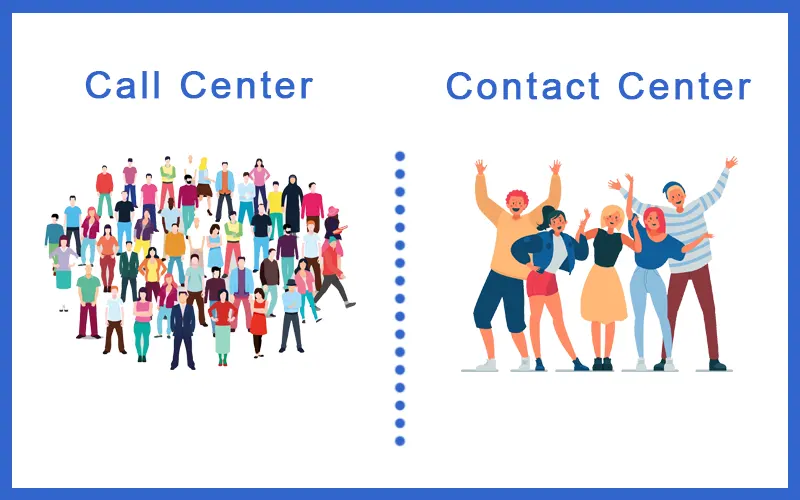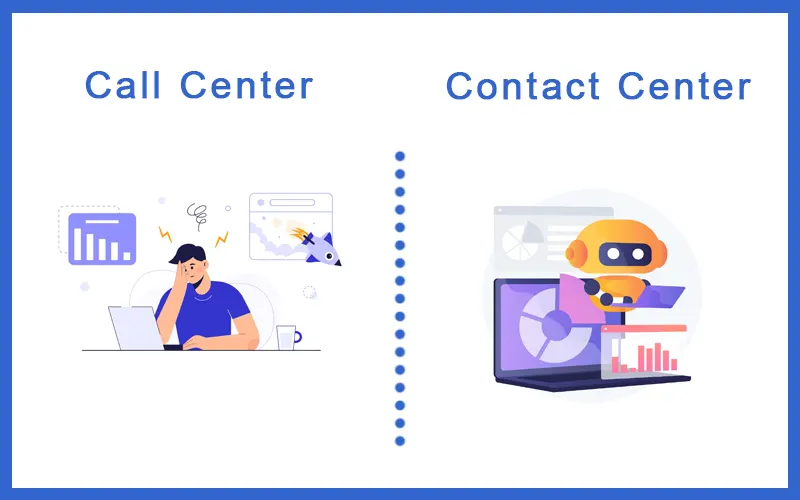Call Center vs Contact Center - Understanding the Differences
The usual scenario in business is that new technology comes and changes the way things work. The situation at present is different, especially when it comes to customer support and success operations.
The main thing driving the change in customer service and success isn't technology but a generational change. It's the Millennials and GenZ who now form the bulk of the consumers in the market.
These two generations grew up with different sets of technologies. They’re more tech savvy and prefer to make full use of technology.
The result? Calls aren't the only way they communicate. There’s instant messaging, social media platforms, video calls and much more.
This is where Contact Centers came in. A lot of people still consider a Call Center and a Contact Center to be synonymous.
In this article, we will learn the differences between them and how they serve different purposes.
What is a Call Center?

A call center is a department within a business or an outsourced entity that handles inbound and outbound communications with customers via voice calls.
Primarily, a call center agent handles the inquiries and difficulties a customer might face. They also provide technical assistance to customers to help them get the most out of their products.
Additionally, they also carry out other ancillary business functions such as telemarketing, gathering feedback, debt collection, billing, grievances and other customer-facing functions.
What is a Contact Center?

A contact center is a department within a business that handles all inbound and outbound interactions with customers across all channels of communication.
The younger generations grew up with evolving technology. They make use of different channels of communication as per their preferences and convenience. This led to the rise of the Omnichannel experience for customers.
The need to provide a uniform customer experience across different channels and media led to the rise of Contact Centers. They perform all the functions a call center performs and more.
With that, you know what a Call Center and a Contact Center are. Let’s dive into their differences for an even better understanding.
Top 8 Differences Between Call Center and Contact Center
While technically the two perform the same function of assisting the customers, how they do so is completely different.
Let us understand these differences in depth!
1. Channels of Communication

It's all in the name when it comes to a Call Center. They make use of a single communication channel, i.e. voice calls.
A Contact Center on the other hand makes use of multiple channels of communication. Email, instant messages, social media platforms, website live chat, etc. are the channels of communication used by contact centers in addition to voice calls.
With a call center, you’re only able to service customer queries via voice calls. This worked well earlier but may not be the ideal approach for the younger generations.
A contact center allows businesses to service customer queries in the way and form they’re comfortable with. This results in a far superior customer experience.
2. The Utility

A call center is a more traditional approach to handling customer support and allied activities. A contact center, on the other hand, handles everything and more but with a different approach.
A call center primarily handled customer support and queries. In terms of additional capabilities, call centers are widely used for other activities such as sales, telemarketing, technical support, etc.
A contact center handles the same function however its focus is more on handling and managing customer relations. The younger generations demand a better experience from brands no matter how they approach them.
Thus, a call center is an ideal option for you if your user base prefers the traditional means of communication.
In case your user base is younger and demands an omnichannel customer experience, a contact center will be your best option.
3. Workforce Requirements

In terms of workforce requirements, a call center is workforce intensive. The reason behind this is how they handle customers. A voice call takes up a call center agent’s entire bandwidth as it is real-time interaction.
As a result, a single call center agent can only handle a single customer at a time. This means a call center will be required to hire agents based on the peak hour requirement. This means most agents will have considerable downtimes adding to costs.
As they’re not restricted to a single channel of communication, contact center agents can service multiple customers in parallel. This makes a contact center less workforce intensive in comparison to a call center.
Better management of customer queries will allow a contact center to scale operations while having the same workforce.
A call center on the other hand will require one to hire additional staff to scale operations.
4. Core Philosophy
In terms of what philosophy the two follow, a call center can be best described as following a reactive philosophy. A contact center on the other hand follows both a proactive and reactive philosophy to maintain customer relations.
By employing a call center, you’re waiting for the customer to run into some trouble first before they contact you. Traditionally, this approach has been effective. However, younger customers expect a lot from brands and businesses now.
A contact center follows both mentioned philosophies. Instead of waiting for a customer to run into trouble, a contact center ensures the customer is assisted throughout their customer journey. While this can be passive at times but it is certainly effective.
Covering both ends makes a Contact Center a more capable solution for handling customer relations and queries.
5. The Problem Solving Approach

The way each of them solve a customer’s problem or answer their queries differs drastically.
A call center has an agent to assist each and every customer that calls seeking help. Most of the time the queries are trivial but take up a lot of time.
Moreover, whether the problem is completely solved or not depends on the agent’s product know-how and communication skills.
A contact center on the other hand takes a different approach. The younger generations are self-sufficient and do not require much assistance to troubleshoot small issues.
To facilitate this, contact centers provide a self-help guide and product documentation. In case a customer is still unable to troubleshoot, he can approach a contact center agent for further assistance through call, chat, email, etc.
6. Level of Customer Journey Insights

This point is where the distinction between an older approach compared to a new one is clearly emphasized. Data is an important resource for any modern business as it enables accurate decision-making.
While most call centers are connected to the firm’s CRM, they do not have a lot of useful or actionable data regarding each customer.
So while the agents might know basic details about their customers, they may not know what issues you have faced in the past pertaining to the products.
In contrast, a contact center has access to a lot of customer journey insights. Details such as past interactions, previously faced issues, troubleshooting history, etc. are all available with a contact center agent.
As a result, a contact center can better assist a customer through these insights. This again results in an enhanced customer experience.
Level of Automation on Offer

Businesses all over are leveraging automation to streamline and better manage business functions. The result? Better effectiveness, efficiency and resource management.
Automation is present in the functions of a call center and a contact center. A call center enjoys automation only up to a certain extent. Functions such as call queuing, IVR, call routing, auto redial, etc. are available to a call center.
In comparison, the operations of a contact center can be automated to a large degree. The only work to be done manually is the direct interactions with the customer handled by the agents.
Ticket generation, task assignment, updates, time-based triggers, auto-escalation, etc. can all be automated in a contact center.
Operational Costs and Scalability

Again, the generational divide between two customer-facing functions is made prominent in this point of comparison.
The central component of a call center is the agent. You need agents to handle all the inbound and outbound calls. So when it comes to scalability, you have to face some strong restrictions as it takes time and money to acquire new agents.
Making use of different channels for communication allows contact center agents to service multiple customers in parallel. Thus, scaling contact center operations is relatively easy and cost-effective.
In terms of operational costs, a call center needs to maintain its peak capacity at all times thus, it increases the cost of operations. A contact center can operate on a relatively small workforce and thus, its operational costs are far lower.
And that was our last top point of distinction between a call center and a contact center!
Concluding With
The advantages of going with a contact center are quite obvious. However, call centers aren’t going away anytime soon. A large portion of customers still prefer interacting via calls and this keeps the call centers relevant in the short run.
The choice between the two comes down to what your customer base looks like. If it consists of a majority of younger generations, a contact center would do you good.
In case your customers prefer calling in more and belong to the older generations, a call center would be the perfect fit for you.
I am sure that in the coming days, new technologies will improve call center operations drastically. We will again have the same discussion sometime in the future.























































































































